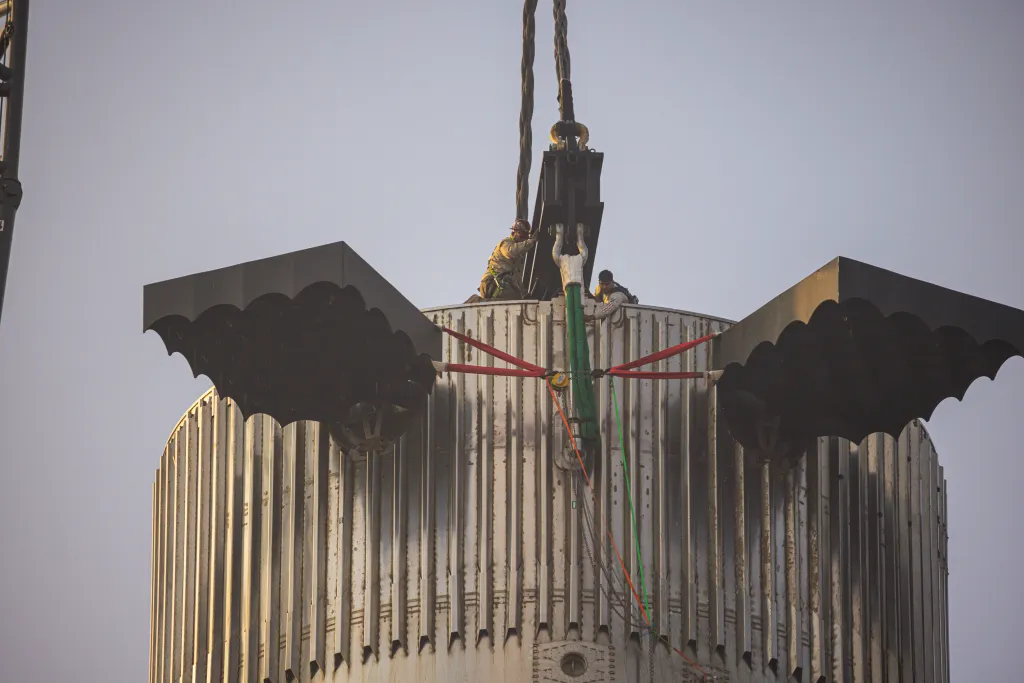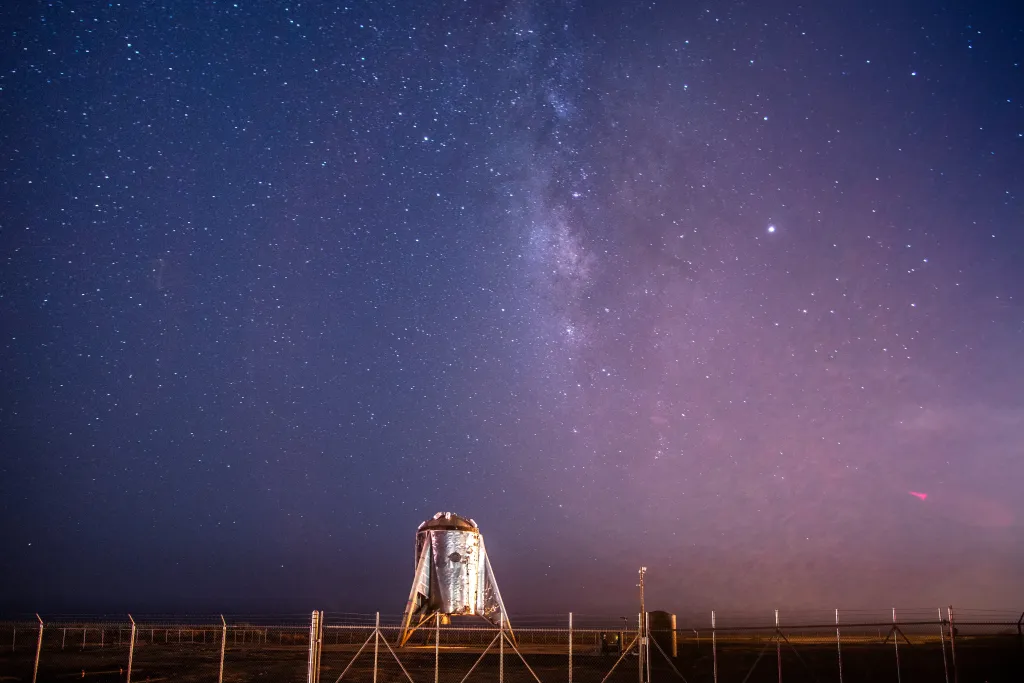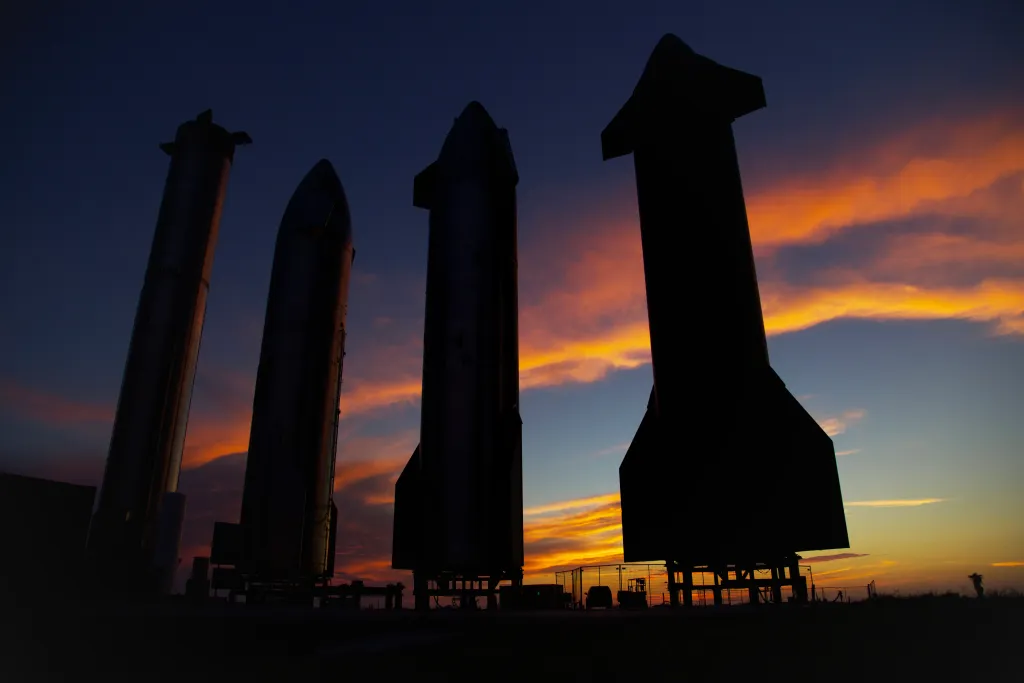Featured Image: Ryan Chilynski/Cosmic Perspective
Lift Off Time | April 20, 2023 – 13:33 UTC | 08:33 CDT |
|---|---|
Mission Name | Starship Flight Test |
Launch Provider | SpaceX |
Customer | SpaceX |
Rocket | Starship/Super Heavy |
Launch Location | Orbital Launch Pad, Starbase, Texas, USA |
Payload mass | N/A |
Where did the spacecraft go? | It uhh… blew up |
Did they attempt to recover the first stage? | No |
Where did the first stage land? | It didn’t |
Did they attempt to recover the fairings? | There are no removable fairings on Starship |
This was the: | – 1st flight of the Starship/SuperHeavy stack – 26th mission for SpaceX of 2023 – 230th mission for SpaceX overall – 1st orbital launch attempt from the state of Texas – 49th flight of a liquid fueled rocket from the state of Texas – 61st orbital launch attempt of 2023 |
Where to watch | Official replay Everyday Astronaut replay |
How Did It Go?
SpaceX launched the full stack or Starship/SuperHeavy for the first time ever. Only four minutes into flight, the vehicle experienced a Rapid Unscheduled Disassembly (RUD) and the vehicle was lost. The explosion occurred after multiple full rotation spins of the full stack.
The vehicle reached an altitude of 39 km (24 miles) before descending uncontrollably. During liftoff, three engines appeared to fail to ignite before leaving the pad. As Starship ascended, more engines were lost, which caused a decrease in thrust. However, Starship continued to rise until about the two and a half minute mark where it began to tumble. Flipping end over end nearly three times before exploding, viewers watched in awe at a Kerbal-like, but real life, scene.

Stage 0, the ground support equipment (GSE), launch table, tower, and other supporting elements that do not leave the ground, has been impacted heavily. The launch table has little-to-no concrete left, one of the GSE tanks that store propellant appears to have a puncture, and the launch tower is singed. It is unclear how long this will take to fully repair, but months to a year would not be out of the question.
Overall, this flight was successful on several levels. The launch was successful and what was only a dream several years ago is now a reality, SpaceX will also have a mountain of data to review and learn from. In years to come, this flight will hold significance, but be much less impactful when Starship begins regular flights and eventually travels to and lands on the Moon.
Starship Flight Test
With the first flight of a fully stacked Starship/Super Heavy comes various objectives and challenges. The end goal of this mission was for Ship 24, also known as “Starship” or the upper stage, to successfully reenter the atmosphere and crash land about 100 km (62 mi) off the coast of Kauai. Kauai is an island in the Hawaiian islands chain located in the Pacific Ocean. There was no known payload on Ship 24; the payload bay door has been welded shut.
If stage separation occurred successfully, Booster 7 would have performed a boostback burn and attempted a soft water landing in the Gulf of Mexico. If Ship 24 had made it to reentry, it would not have attempted a soft water landing.
The Pad
In the days prior to launch, Ship 24 was placed on top of Booster 7 via the chopstick arms, also known as Mechazilla. Once on top, the arms released and opened wide near the top of the tower in order to get as far away from the stack as possible. These chopstick arms are designed to catch both the booster and ship on future missions.
In the weeks after the 31-engine static fire and leading up to launch, SpaceX installed enhanced shielding on the Orbital Launch Table in order to provide better protection during launch. There is no flame diverter, unlike on other launch pads, so the exhaust from all 33 engines spread in all directions causing immense destruction.

Starship/Super Heavy
For the past seven years, SpaceX has been developing their facility in Boca Chica, Texas. They have dubbed it “Starbase” and it contains tents, bays of various heights and widths, as well as all the infrastructure to produce the world’s largest and most powerful rocket. Information on the test campaign and the construction of Ship 24 and Booster 7 can be found in the “History” section below.
The full stack consists of two vehicles, each with different jobs relating to the launch process. On the bottom is the booster, also known as Super Heavy, which makes up about 58% of the full stack. The orbital ship rests on top of the booster to enable easy separation during staging.

The Booster
The booster, or bottom part of the rocket, is powered by 33 Raptor 2 engines formed in a series of rings standing 69 m (230 ft) tall. To fuel all 33 engines, uses a liquid oxygen (LOx) tank and a methane (CH4) tank on the bottom and top, respectively. The booster is fueled by the Booster Quick Disconnect (BQD) which is located on the Orbital Launch Table and connects to the booster near the bottom.

Shortly before the booster experiences first motion, the BQD retracts and a protective door rapidly shuts in order to prevent the connections from getting blasted by rocket engine exhaust. Near the bottom of the booster are four elongated triangular chines. Each of these contain Composite Overwrapped Pressure Vessels (COPVs). The COPVs provide helium and other gasses for engine start up and other functions on the booster. The square trapezoidal pyramids mainly contain electronics units.
On the top of the booster are four grid fins which provide control during booster descent through the atmosphere. These work similarly on the Falcon 9, however are much larger on Super Heavy.

All 33 sea-level Raptor 2 engines are arranged in three clusters or rings. The three inside engines form a triangle and have the ability to gimbal. The next ring contains 10 engines which also have the ability to gimbal. Finally, the outer ring contains the remaining 20 engines that do not have the ability to gimbal.
The Ship
The Ship, or top part of the rocket, is powered by three sea-level Raptor 2 engines, and three vacuum optimized Raptor 2 engines, and stands 50 m (160 ft) tall. The three vacuum optimized engines have elongated bells to adapt to the lack of air pressure in space. To learn more about Raptor engine development, check out Everyday Astronaut’s video “How SpaceX Is Upgrading Raptor To Be The Ultimate Rocket Engine!“
On the bottom of the ship is a skirt which encloses the engines and provides a structural element for the booster and ship to connect. Unlike the Falcon 9, the interstage section on starship is on the ship and the top of the booster is the top bulkhead. During stage separation, the booster will perform a kick and flip maneuver to separate the ship from the booster. Using the inertia of the kick from the booster, the ship will separate and then ignite all six engines to continue on its path to orbit.

The bigger of the two sets of flaps, the aft flaps can work in conjunction with the three center mounted sea-level engines that gimbal, to orient the ship during entry and landing. On the top of the ship are the slightly smaller forward flaps that also aid in ship orientation during descent and landing.
About two-thirds of the way up the vehicle is the payload bay. Designed for Starlink satellites, there is a narrow door that deploys one satellite at a time. Sometimes called the “PEZ dispenser,” named after the popular candy, the internal structure of the payload bay is specially designed to deploy Starlink satellites in this manner.
Starship Program History
For nearly all of its lifetime, the Starship program has resided in south Texas, at Starbase. The area where Starbase resides has progressed through many names over the past decades. The town where Starbase is located was originally called Kennedy Shores. After a hurricane it was renamed Kopernik Shores, and most recently known as Boca Chica.
Originally purchased in 2014, the land in the area of Boca Chica gradually fell into SpaceX’s hands. For the next four years, progress was fairly dormant, despite some occasional ground work. In 2018, a water tower-like structure first stood on the paper-flat landscape. This “water tower” would be later known as Starhopper, a Raptor engine test vehicle.
Test Hops
Starhopper flew untethered for the first time on July 25, 2019 under the power of one Raptor engine serial number six to a height of 20m (65 ft). A little over a month later, Starhopper would fly for the second and final time, reaching a height of 150m (500 ft). The main purpose of Starhopper was as a Raptor flight test vehicle. Presently, Starhopper remains at the launch site, covered in speakers, cameras, and other communication and monitoring equipment.

Two more test vehicles would fly to a height of 150m (500 ft), SN5 and SN6. However, before these two successes came a spectacular malfunction of SN4. While conducting a static fire test, SN4 suffered an explosion, or a rapid unscheduled disassembly, which quickly ended it’s testing career. SN5 and SN6 would launch a year after Starhopper, about one month apart.
First Flights
At this point, SpaceX transitioned to higher flights which would utilize three Raptor engines and aimed to test the belly flop, flip, and landing maneuver. The first Starship to attempt this maneuver would be SN8, which launched on December 9, 2020 and flew to an altitude of 12.5 km (41,000 ft). Flying for a total duration of six minutes, 42 seconds, the flight concluded in SN8 crashing on the landing pad. A sudden pressure loss in the methane header tank caused the engines to stop producing thrust, resulting in a rapid unscheduled disassembly of the vehicle.
SN9 would be next up in line to attempt a successful landing. SN8 had already proved that Starship could perform a belly-side-down dive, relight it’s engines, and (partially) flip over. During construction, SN9 fell over in the High Bay which caused concern for its structural integrity. SN9’s flight was the same as SN8, however, it only traveled to 10 km (33,000 ft) in altitude. Upon landing, one of it’s three Raptor engines failed to relight resulting in an over rotation of the vehicle. SN9 landed at a slight angle and exploded on the landing pad.

SN10’s flight came with an emotional roller coaster. As it’s predecessor did, SN10 flew to 10 km (33,000 ft) and performed is descent maneuver as designed. The flip and engine relight went smoothly, but a hard touchdown damaged the skirt and fragile landing legs. After standing poised on the landing pad, about eight minutes later, SN10 also exploded in a massive fireball.
Explosion and Success
SN11 still remains a large mystery. Due to the abnormally dense and low lying fog, the entire flight was entirely obscured, leaving the only evidence of flight to the in-person observer, the sound, and a still image captured by Trevor Mahlman. Upon landing and relight, SN11 rapidly exploded scattering debris across the area around starbase for miles. The only visuals of this explosion were from ground based cameras that saw debris falling from the sky.
Finally, SN15 was the first Starship prototype to fly to 10 km (33,000 ft), dive down on its belly, flip, and land successfully. The prototypes between SN11 and SN15 allowed for necessary upgrades which enabled a successful landing. While a small fire ignited underneath the vehicle, it was quickly extinguished allowing SN15 to live on. Currently, SN15 sits with other vehicles in the Rocket Garden.

Recent Updates
Although SN15, which flew almost two years ago in May 2021, was the last flight from Starbase, testing and rapidly accelerated construction has progressed and changed the landscape. Some highlights of this construction include the completion of the Orbital Launch Tower and Orbital Tank Farm. Both of these elements, in conjunction with the Orbital Launch Table, are essential parts of Stage Zero. Stage Zero is, simply put, the launch pad and supporting equipment that enables an orbital launch.
As far as rockets go, SpaceX tested BN3 (Booster Number 3) marking the first static fire of a booster prototype on July 19, 2021. BN3 was quickly scrapped a month later, but paved the way for B4 (Booster 4), which never performed a static fire test, but was part of the first full stack of the Starship/SuperHeavy launch system.
Conclusion
These previous boosters, along with B5 that never saw testing, paved the way for Booster 7 and Ship 24 to conduct the first orbital flight test. Each explosion, successful landing, static fire test, cryogenic proof test, and even simple rollouts to the pad have allowed SpaceX to test critical elements in preparation for orbital flight. As the predecessors did for B7 and S24, the pair will gather data on orbital flight to enable further success on future orbital launch attempts, regardless of the outcome.






A self generated lightning bolt struck SS above the cloud layer. A video shot from a plane showed he bolt run the entire length of the exhaust plume. Shortly after is when it tumbled. I have no idea if these events were related… but it might be worth looking at.
Never mind… just realized the video I saw was faked. Faked videos these days
are too good. 🙁
It seems that no flame trench for the launch pad is problem which would prevent any feasible turnaround capability for the vehicle. Also wondering if the booster damaged some of its engines with flying debris before it left the pad – causing some to fail immediately and maybe others to fail in-flight. Can you post any information about SpaceX’s longer term plans for the launch facility? I heard they might be leasing a VAB bay from NASA. Might they also be contemplating long-term use of 34A/B at Cape Canaveral?
IMO there are high chances for the OLM to need rebuild from scratch, with some reuse of parts from the original disasembly. Upper part of foundation has been shattered by Starship start and I see no chance for various piping and cabling under it to survive. OLM seems to be laid on pillars (piles) hammered deeply into the ground, possibly all the way long to rockbed below. If it is the case, it can be reused, assuming the layout of pillars does not interfere significantly with smooth flow of flame in the trench to be build. I think they’ll measure OLM precisely and if they found it tilted in any way, will have to scrap it.
Regarding launch infrastructure, there are tanks and other high pressure armament that might need preplacement after it went through shooting with OLM foundation debris. Not all damage is visible and easy to check. Some tanks certified for high pressure cryogenics might have lost their certification.
I would love for Elon’s words “next start in couple of months” to come true, but for this Stage Zero & Co., one year at least seems be more realistic.
a picture of the hole underneath the (former) launch pad would be helpful, esp.for those that missed the original shot – it probably came from SpaceX so it might no longer be available.
Thank you for sharing the link about the Starship Superheavy flight test. It’s an exciting development in the realm of space exploration. The Starship program has been generating a lot of interest and anticipation among space enthusiasts.
The test flights of the Starship and Superheavy are significant milestones in SpaceX’s ambitious plans for human space exploration and colonization of other planets, particularly Mars. It’s impressive to see the progress they have made in developing a fully reusable spacecraft that has the potential to revolutionize space travel.
I’m eager to learn more about the specifics of the test flight mentioned in the article. SpaceX’s dedication to innovation and their pursuit of reusability in space transportation has already proven successful with the Falcon 9 rocket, and it will be fascinating to see how the Starship system performs.
The exploration and expansion of our presence in space have always been of great importance, and projects like the Starship program offer new possibilities for scientific research, commercial ventures, and the eventual colonization of other celestial bodies. It’s an exciting time for space enthusiasts, and I look forward to following the progress of the Starship Superheavy flight tests and the future of space exploration.